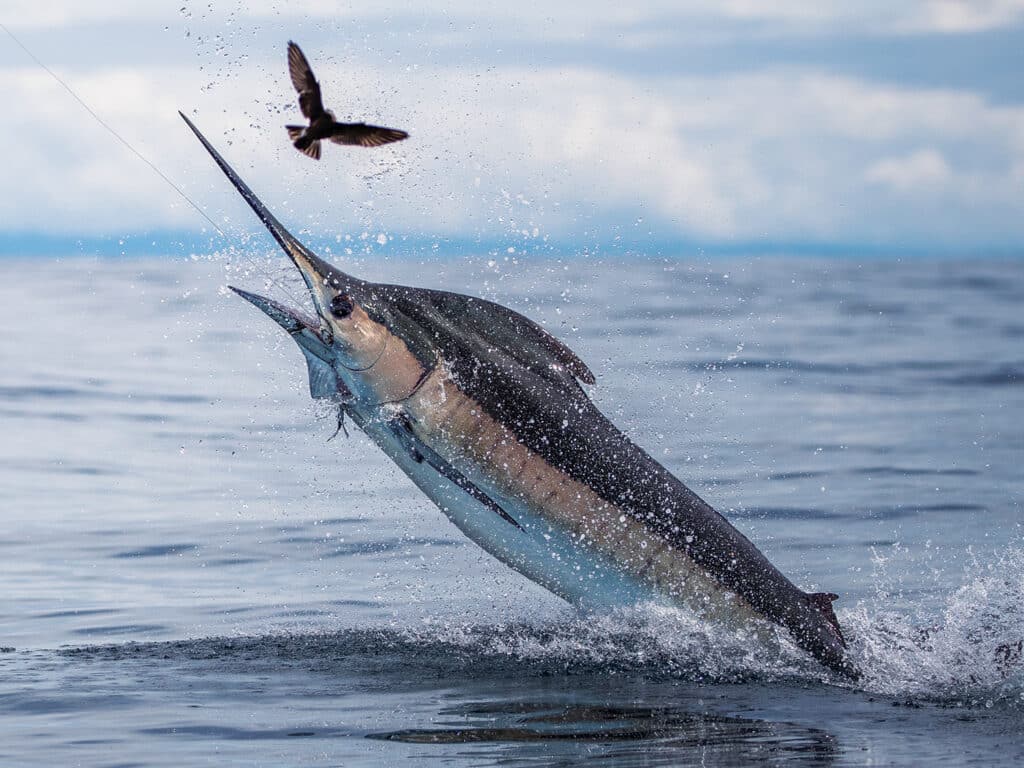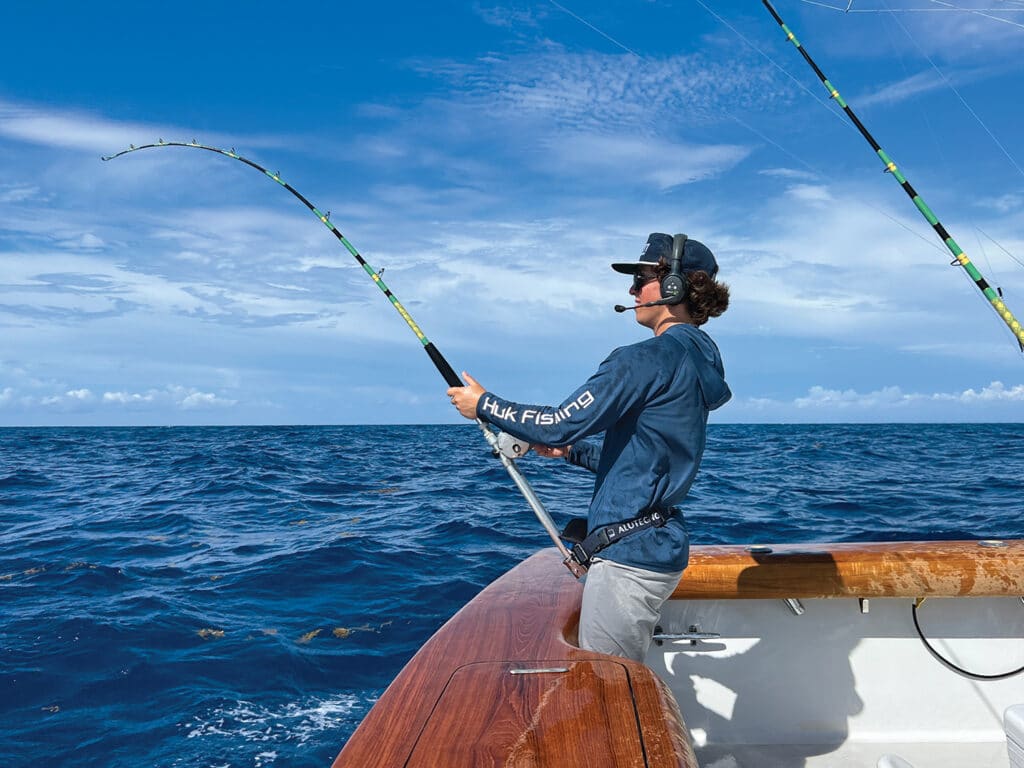
Special delivery: Sign up for the free Marlin email newsletter. Subscribe to Marlin magazine and get a year of highly collectible, keepsake editions – plus access to the digital edition and archives.
“Bogey incoming, 125 feet down,” sounded like a dogfight straight out of Top Gun. But then, the fish came flying up from the depths and inhaled one of our ballyhoos. I strapped myself into the harness and began the fight, praying he would stay pinned.
The importance of billfish and what they mean to the oceans has always fascinated me, even as a young kid. Their strength, resilience, and prowess among other gamefish lured me into an obsession, just as it had with all others who love to fish. Even if someone had no way of catching one, the marlin was almost always seen as a pinnacle goal, and worthy of protection.
Landlocked, not Locked Out
Even though I’ve lived my entire life far from the ocean in Atlanta, I have been exposed to lots of fishing in many parts of the world. My parents were supportive and shared my interests. At 10 years old, I was able to add my name to the IGFA’s World Record Game Fishes when I caught a billfish grand slam in Cabo San Lucas, Mexico.
When I was 12, my dad and I joined the IGFA as lifetime members and were entered into an auction for a free trip to Tropic Star Lodge in Panama—and we won. Regarded as one of the best fishing destinations on the planet, Panama boasts the highest number of IGFA world records anywhere. We loved it so much, we decided to return at the end of the same year. That was the trip that started my journey to help preserve the billfish that call Panama home.
Purely by coincidence, I sat down at the lodge next to Bob and Sally Kurz, who helped co-found the IGFA’s Great Marlin Race—a branch dedicated to the research and protection of billfish across the globe. They explained what the IGMR was, and my mind instantly raced through the possibilities of what I could do to help. Being a part of the next generation of great fishermen, I had come to assume my duty to not only catch, but also protect the fish and the sport I had come to love. The Kurzes did their best to educate me on what they did when tagging a marlin, and the procedure glued into my mind. All I could dream about that night was catching a marlin I could put a tag in. I was going to do it one day; I just didn’t know exactly how. By the end of the trip, the most important thing I did was figure out my plan. I had found an outlet to further my influence on sport fishing, but I greatly underestimated what it would take.
Fish the Plan
Not knowing where to start, I began to reach out to friends and family to scrounge for whatever money I could. While my proposal wasn’t well-thought-out, I also didn’t know what, exactly, to do with the money once I received it. That’s when I began to address the issues I could see in front of me. I set up a separate bank account to manage my donations, and I worked on a script that I practiced when explaining my goal to potential donors. By not only asking but also doing random jobs around Atlanta, I slowly but surely made the money.
I knew that I needed to get a PSAT tag to register through the IGMR, but I had no idea from where. Thankfully, I was invited back to the IGFA’s annual auction held in Fort Lauderdale, Florida, by the Kurzes. And just like that, the stars aligned, and I met the manager of the IGMR, Dr. Bruce Pohlot. I explained my hopes for the money I raised, and he shared a great deal of enthusiasm toward my efforts and passion for the cause. Because of that, the IGFA granted me a tag.
Soon after, I was off to the Dominican Republic, tag at the ready, intending to place it in a healthy Atlantic blue marlin. On the days leading up to the trip, I couldn’t stop thinking about the brief moment I would have to place the tag into the fish. Everything had to be perfect: the pitch, the connection, the fight and the tag placement. I spent hours relentlessly watching videos on marlin tagging, right up until the night before.
I woke up to parrots flying around Casa de Campo in the DR, and quickly grabbed everything I needed. I was on the way to Delta Dawn with my dad and a friend of mine, where we met Capt. Pete Manuel and his mate, Jose Antonio Suárez. We talked about the plan, prepared the tag stick, and headed off to the FADs. After an hour of running, we put three lines out, ensuring that we didn’t have any chance of a tangle. Not even a minute into fishing, Manuel spoke into his headset and told us he had seen something on the sonar; we readied ourselves for a bite. Sure enough, just like clockwork, there it was. The strength of this fish was ridiculous; he made at least five runs before we got him closer to the boat. At the sight of the boat, he went nuts, jumping everywhere and doing multiple backflips.
While the fish wasn’t big, he was a testament to the reason why blue marlin have become the crown of gamefish, even as he fought for nearly two hours. After all that, we ended up not tagging it, thinking he might be at risk for shark depredation. Unfortunately, we didn’t get another bite for the rest of the day.

If at First You Don’t Succeed
The next day, we ran out to the same grounds as the day before. Although it took a while, we finally got a bite and fought the fish for almost an hour and a half before it frayed through the leader. We felt defeated, but we got another shot in the last hour of fishing. This fish cooperated perfectly. As I fought it, I kept overthinking the tagging process. Finally letting my brain relax, we got the 150-pound blue marlin boatside. And smooth as silk, I handed the rod to my dad as I grabbed the pre-rigged tag stick. I took one glance at the fish and held the stick steady. Then, boom, the tag was in and perfectly placed. Even though we fought this fish for only about 30 minutes, we quickly and carefully revived it, paying close attention to make sure it was in good health.
I let go of the bill and watched the fish slowly descend behind the transom, wondering when the tag would eventually pop up, and what we would learn from it.
After succeeding at my goal of placing a sat tag in a blue marlin, life gradually began to slow down, and I was able to appreciate the little details that helped me get to that point. For example, fishing in the DR with Capt. VJ Bell on Unbelievable the previous year allowed me to hone my understanding of the fishery, giving me knowledge of what I could expect and allowing me to visualize the process of placing a tag in a fish. And thankfully, people like Pohlot had been monitoring my progress and spoke well on my behalf.
Read Next: Learn more about satellite tagging here.
Because of this, Bass Pro Shops allowed me to deploy three PSATs from their IGFA grant through the Bass Pro Shops and Cabela’s Outdoor Fund. I was instructed to place these tags on white marlin this time, again in the Dominican Republic. We were able to get two of the tags in whites on one day of fishing with Bell, and a few days later, got the third deployed with Delta Dawn.
Throughout this process, I have learned not only about billfish and why they needed to be protected, but also a lot about myself. The ocean had been a second home to me for my entire life and always offered opportunities around each corner. Marlin just happened to be the thing that I felt most connected to. I couldn’t be more excited to continue my work well into the future.
For more information on the IGFA Great Marlin Race, please visit igfa.org.







